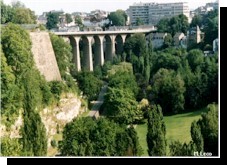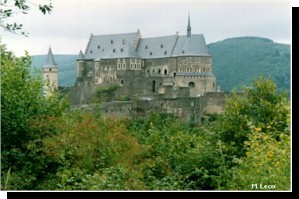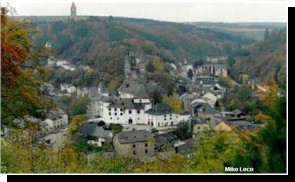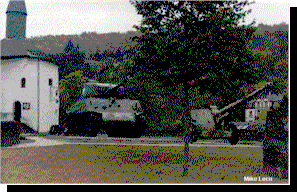

![]()
In 1963, Luxembourg City
celebrated it's "millennium". It had been a chartered
city for one thousand years! Sigefried, Count of the Ardennes,
erected a castle in 963 on the rocky promontory rising above the
valleys formed by the meanders of the Alzette
river. Evidence indicates that the natural fortifications of the
site may have been used to protect Gallic encampments and Roman
outposts for a thousand years prior to Sigefrieds arrival.
Over the centuries, this castle with it's adjoining city, set
atop the rocky cliffs, was strengthened with numerous
fortifications, walls and gates until it became known as the
"Gibraltar of the North". Even the cliffs themselves
were hollowed out to form a maze of tunnels known as the
"Casemates".
 |
Much of the old city (61k jpg) of Luxembourg still stands atop those fortified cliffs. Many of the ancient walls and gates have been restored. Today, you can walk along those fortifications or descend into the valleys of the Alzette and the Pétrusse through one of the old city gates (58k jpg). You can explore the narrow winding streets, pass the palace of the Grand Duke and pause for a drink at a sidewalk café at the Place d'Armes (44k jpg). You can even tour the Casemates (44k & 50k jpgs) beneath the city. It is one of the most beautiful and photogenic cities in Europe. |
![]() Return to
Top
Return to
Top
![]() Back to Home
Page
Back to Home
Page
![]()
| Vianden (49k & 47k jpgs) is a small picturesque village situated on
both banks of the Our River. It has a magnificently restored medieval castle, the origins of which date back to the 9th Century, overlooking the town. Originally the home of the Counts of Vianden, whose years of glory spanned the 11th and 13th centuries, it is a true architectural gem. In the 17th Century, it was partially destroyed by fire and earthquake. The Grand Duke of Luxembourg and Guillaume !, King of the Low Countries, sold the castle in 1820. |
 |
Soon afterwards it fell into
disrepair. Eventually, the Grand-Duke Adolphe gained ownership of
the castle. It remained in the family until, in 1978, Grand-Duke
Jean gave the castle to the state. At this point reconstruction
began to make this remarkable Middle Age structure the
breath-taking historical landmark that it is today. It is a
pleasant day trip, about 40 km. (25 mi.) north of Luxembourg
city, and well worth visiting.
Victor Hugo visited Vianden while in voluntary exile in 1871. He
wrote:
"Vianden consists of two things, both of which are as
comforting as they are magnificent. One is sinister - its ruin;
the other cheerful - its people!"
![]() Return to Top
Return to Top
![]() Back to Home
Page
Back to Home
Page
![]()
| Clervaux (38k jpg) is about 50 km (30 miles) north of Luxembourg City in the heart of the Ardennes Mountain region known locally as the Eisleck. The village nestles in a crook of the Clerve river and is overlooked by a 15th century castle, a Romanesque church with twin spires and a large Benedictine monastery (16k jpg). |  |
The castle now houses several small museums. They contain scale model replicas of every castle in Luxembourg; a photographic exhibit dedicated to Luxembourg born photographer Edward Steichen and a collection of World War II memorabilia from the Battle of the Bulge that was fought in the region. Most poignant of all, is the room dedicated to the Luxembourg Holocaust. Its walls are lined with thousands of identity papers, interment orders, and obituaries of Luxembourgers who died on the battlefield, in concentration camps or before firing squads while fighting for their freedom during the World War II occupation.
 |
In the courtyard (34k jpg) before the castle, stand a single German 88mm gun and an American Sherman tank with an 88mm hole drilled neatly through the base of its gun turret. If you ask any "old timer" from Clervaux, he or she will enthusiastically relate the story of "The liberation of Clervaux." It sounds a bit different each time, but it usually involves a handful of German occupiers with a single artillery gun and a lone American tank. |
![]() Return to
Top
Return to
Top
![]() Back to Home
Page to learn more about
Luxembourg, that fairy tale monarchy with magnificent castles and
quaint villages.
Back to Home
Page to learn more about
Luxembourg, that fairy tale monarchy with magnificent castles and
quaint villages.